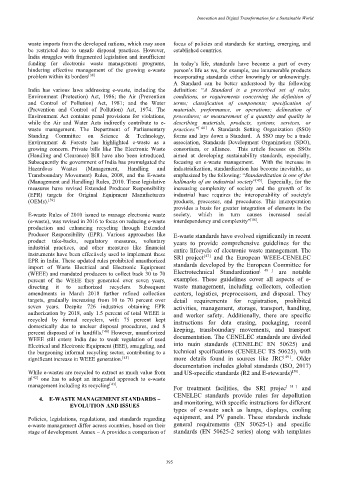Page 439 - Kaleidoscope Academic Conference Proceedings 2024
P. 439
Innovation and Digital Transformation for a Sustainable World
waste imports from the developed nations, which may soon focus of policies and standards for starting, emerging, and
be restricted due to unsafe disposal practices. However, established countries.
India struggles with fragmented legislation and insufficient
funding for electronic waste management programs, In today’s life, standards have become a part of every
hindering effective management of the growing e-waste person’s life as we, for example, use innumerable products
problem within its borders [38] incorporating standards either knowingly or unknowingly.
A Standard can be better understood by the following
India has various laws addressing e-waste, including the definition: “A Standard is a prescribed set of rules,
Environment (Protection) Act, 1986; the Air (Prevention conditions, or requirements concerning the definition of
and Control of Pollution) Act, 1981; and the Water terms; classification of components; specification of
(Prevention and Control of Pollution) Act, 1974. The materials, performance, or operations; delineation of
Environment Act contains penal provisions for violations, procedures; or measurement of a quantity and quality in
while the Air and Water Acts indirectly contribute to e- describing materials, products, systems, services, or
waste management. The Department of Parliamentary practices.” [ 44 ] A Standards Setting Organization (SSO)
Standing Committee on Science & Technology, forms and lays down a Standard. A SSO may be a trade
Environment & Forests has highlighted e-waste as a association, Standards Development Organization (SDO),
growing concern. Private bills like The Electronic Waste consortium, or alliance. This article focuses on SSOs
(Handling and Clearance) Bill have also been introduced. aimed at developing sustainability standards, especially,
Subsequently the government of India has promulgated the focusing on e-waste management. With the increase in
Hazardous Wastes (Management, Handling and industrialization, standardization has become inevitable, as
Transboundary Movement) Rules, 2008, and the E-waste emphasized by the following: “Standardization is one of the
(Management and Handling) Rules, 2010. These legislative hallmarks of an industrial society” [45] . Especially, for the
measures have revised Extended Producer Responsibility increasing complexity of society and the growth of its
(EPR) targets for Original Equipment Manufacturers industrial base requires the interoperability of society's
(OEMs). [39] products, processes, and procedures. This interoperation
provides a basis for greater integration of elements in the
E-waste Rules of 2010 issued to manage electronic waste society, which in turn causes increased social
(e-waste), was revised in 2016 to focus on reducing e-waste interdependency and complexity” [46] .
production and enhancing recycling through Extended
Producer Responsibility (EPR). Various approaches like E-waste standards have evolved significantly in recent
product take-backs, regulatory measures, voluntary years to provide comprehensive guidelines for the
industrial practices, and other measures like financial entire lifecycle of electronic waste management. The
instruments have been effectively used to implement these [ 47]
EPR in India. These updated rules prohibited unauthorized SRI project and the European WEEE-CENELEC
import of Waste Electrical and Electronic Equipment standards developed by the European Committee for
(WEEE) and mandated producers to collect back 30 to 70 Electrotechnical Standardization [ 48 ] are notable
percent of the WEEE they generated over seven years, examples. These guidelines cover all aspects of e-
directing it to authorized recyclers. Subsequent waste management, including collectors, collection
amendments in March 2018 further refined collection centers, logistics, preprocessors, and disposal. They
targets, gradually increasing from 10 to 70 percent over detail requirements for registration, prohibited
seven years. Despite 726 industries obtaining EPR activities, management, storage, transport, handling,
authorization by 2018, only 1.5 percent of total WEEE is and worker safety. Additionally, there are specific
recycled by formal recyclers, with 75 percent kept instructions for data erasing, packaging, record
domestically due to unclear disposal procedures, and 8 keeping, transboundary movements, and transport
percent disposed of in landfills. [40] However, unauthorized
WEEE still enters India due to weak regulation of used documentation. The CENELEC standards are divided
Electrical and Electronic Equipment (EEE), smuggling, and into main standards (CENELEC EN 50625) and
the burgeoning informal recycling sector, contributing to a technical specifications (CENELEC TS 50625), with
significant increase in WEEE generation. [41] more details found in sources like JRC [ 49 ] . Older
documentation includes global standards (ISO, 2017)
While e-wastes are recycled to extract as much value from and US-specific standards (R2 and E-stewards) [50] .
it [ 42] one has to adopt an integrated approach to e-waste
management including its recycling [43] . For treatment facilities, the SRI projec [ 51 ] and
CENELEC standards provide rules for depollution
4. E-WASTE MANAGEMENT STANDARDS – and monitoring, with specific instructions for different
EVOLUTION AND ISSUES
types of e-waste such as lamps, displays, cooling
Policies, legislations, regulations, and standards regarding equipment, and PV panels. These standards include
e-waste management differ across countries, based on their general requirements (EN 50625-1) and specific
stage of development. Annex – A provides a comparison of standards (EN 50625-2 series) along with templates
– 395 –

